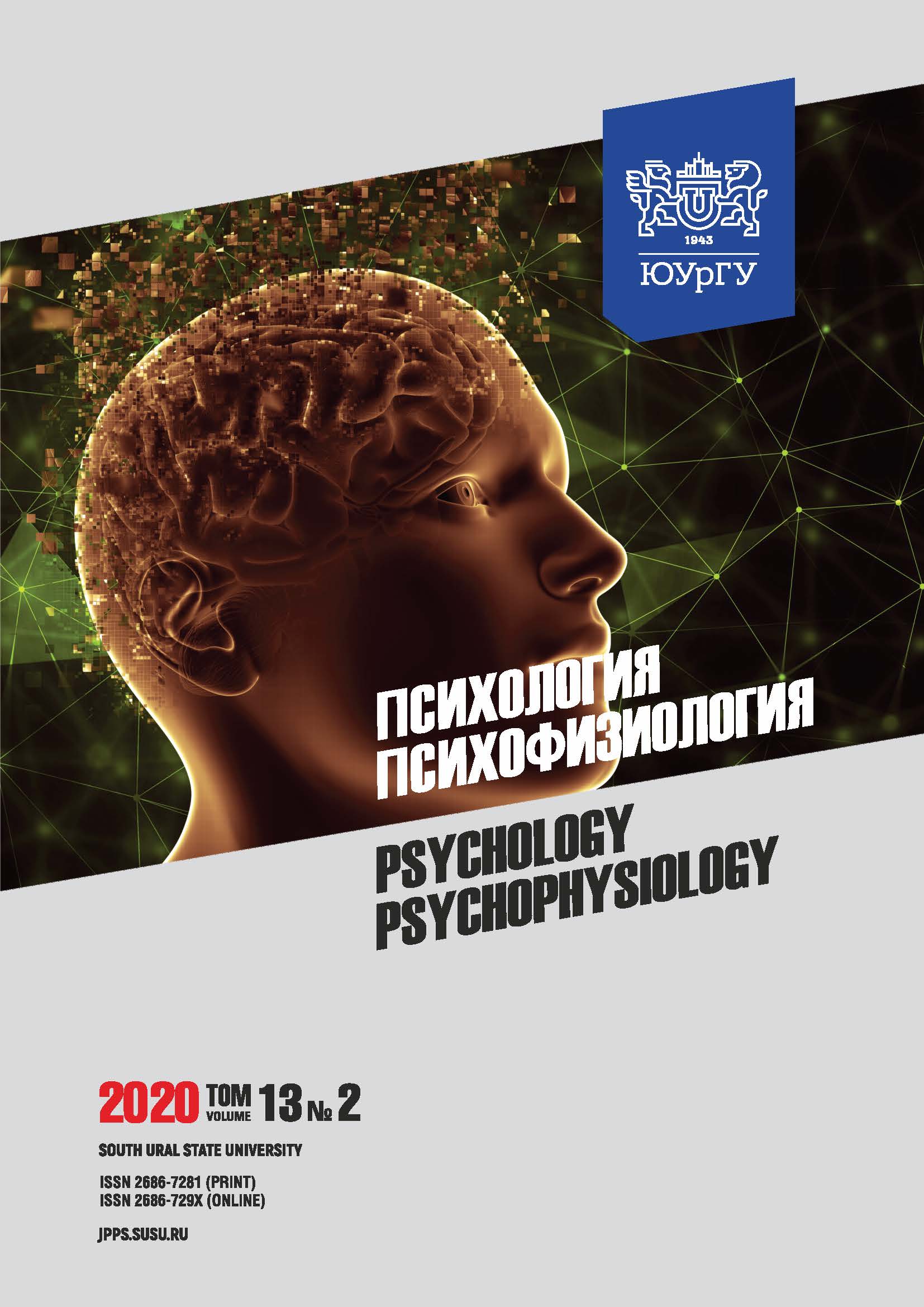ON THE RELATIONSHIP BETWEEN INTUITION AND SELF-AGGRESSION AS A POSSIBLE MARKER OF SUICIDALITY
Abstract
The relationship between intuition and self-aggression, which can be expressed in self-harm and suicide, has not been studied much, while Russia currently ranks second in suicides in the world, and intuition has a major impact on decision-making and behaviour. Aim. The paper aims to study the relationship between intuition and self-aggression as a correlate of potential to suicidal activity among socially adapted respondents. Materials and methods. 72 people participated in the study, 48 females and 24 males, with the mean age of 20 years. The sample consisted of university students and teachers. The following questionnaires were used: Types of aggressiveness by L. Pochechut and Test for empathic abilities by V. Boyko. These questionnaires contain self-aggression and an intuitive channel of empathy scales and, thus, reflect various aspects of intuition. The following statistical methods were also used: descriptive statistics, Kendall correlation analysis, Mann–Whitney criterion, K-means method of cluster analysis, χ2 Pearson test.
Results. Over the entire sample, the correlation between self-aggression and intuition was close to zero. However, when the sample was divided by the parameters of intuition and selfaggression using the K-means method, highly differentiated types were identified: 62.5 % of the subjects were characterized by increased self-aggression and decreased intuition, 37.5 % – by low self-aggression and average intuition. Members of the first cluster also had a significantly higher overall and emotional aggression, as well as lower penetrating ability of empathy. There were no significant gender and age differences between the clusters. Conclusion. Thus, the types that were highly differentiated by absolute differences and statistical significance were detected as those characterized by: 1) increased self-aggression and decreased intuition, 2) low selfaggression and average intuition
Downloads
References
2. Vasilieva I.V., Grigoryev P.E., Ivantsov S.V., Ignatov A.N. [Features of intuition in convicts of violent crimes]. Chelovek: prestupleniye i nakazaniye [Man: crime and punishment], 2016, no. 2 (93), pp. 108–114 (in Russ.).
3. Dashenko V.I. [Autoaggression and suicide: correlation of concepts and their difference]. Lichnost v kulture i obrazovanii: psikhologicheskoye soprovozhdeniye, razvitiye, sotsializatsiya [Personality in Culture and Education: Psychological Support, Development, Socialization], 2013, no. 1, pp. 52–55. (in Russ.).
4. Zakharkin D.D. [Types of intuition and methods for their diagnosis]. Psikholog [Psychologist], 2017, no. 1, pp. 62–76. DOI: 10.7256/2409-8701.2017.1.20278. (in Russ.).
5. Kanevskiy V.I. [Psychological correlates in youth with suicidal thoughts]. Suitsidologiya [Suicidology], 2015, vol. 58, no. 2 (19), pp. 58–63. (in Russ.).
6. Kudryavtsev I.A., Dekalo E.E. [Clinical and psychological markers of suicidal risk]. Rossiyskiy psikhiatricheskiy zhurnal [Russian Psychiatric Journal], 2012, no. 4, pp. 29–35. (in Russ.).
7. Moiseeva L.A., Solovieva E.V. [Psychological and neurophysiological aspects of the phenomenon of intuition]. chelovek. Iskusstvo. Vselennaya [Man. Art. Universe], 2016, no. 1, pp. 170–182. (in Russ.).
8. Naumenko E.A. Vvedeniye v teoriyu intuitsii i intuitivnosti [Introduction to the theory of intuition and intuition]. Tyumen, Tyumen State University Publishing House, 2013. 212 p. (in Russ.).
9. Naumenko E.A. Metodika otsenki urovnya intuitivnosti osuzhdennykh v usloviyakh arkticheskogo regiona [Methodic for assessing the level of intuitiveness of prisoners in the Arctic region]. Istoriya, ekonomika, kultura v transgranichnykh issledovaniyakh Severa (Arktiki) [History, Economics, Culture in Cross-Border Studies of the North (Arctic)]. Khanty-Mansiysk, 2019, pp. 245–254. (in Russ.).
10. Polikarpov V.A., Raparovich N.A. [Methods of research of intuition in the process of solving prognostic tasks]. Psikhologicheskiy zhurnal [Psychological journal], 2014, no. 1-2, pp. 60–66. (in Russ.).
11. Pochebut L.G. Kross-kulturnaya i etnicheskaya psikhologiya [Cross-cultural and ethnic psychology]. St.Petersburg, Peter Publ., 2012. 336 p. (in Russ.).
12. Rozanov V.A. [Evolutionary and ethological aspects of suicide]. Suitsidologiya [Suicidology], 2017, vol. 8, no. 3(28), pp. 3–20. (in Russ.).
13. Bem D., Tressoldi P., Rabeyron T., Duggan M. Feeling the future: A meta-analysis of 90 experiments on the anomalous anticipation of random future events. F1000Res, 2015, vol. 4, no. 1188. DOI:10.12688/f1000research.7177.2.
14. Epstein S. Demystifying intuition: what it is, what it does, and how it does it. Psychological inquiry: an international journal for the advancement of psychological theory, 2010, vol. 21, no. 4, pp. 295–312. DOI: 10.1080/1047840X.2010.523875
15. Halicka J., Kiejna A. Differences between suicide and non-suicidal self-harm behaviours: a literary review. Archives of Psychiatry and Psychotherapy, 2015, no. 3, pp. 59–63. DOI: 10.12740/APP/58953.
16. Jordan R. Essential Social Skills: How to de-Escalate Aggression and Resolve Conflict. R. Verbeek, Hengelo, The Netherlands, 2018. 171 p.
17. Kahneman, D. A Perspective on Judgment and Choice: Mapping Bounded Rationality. American Psychologist, 2003, vol. 58, pp. 697–720. DOI: 10.1037/0003-066X.58.9.697.
18. Rodziński P., Ostachowska A., Cyranka K. et al. Neurotic personality traits and associated dysfunctional attitudes as factors predisposing patients to suicidal ideations at the end of intensive psychotherapy. Psychiatr Pol., 2019, vol. 53, no. 4, pp. 883–899. DOI: 10.12740/PP/89795.
19. Kao Y.C., Liu Y.P. Suicidal Behavior and Insight into Illness among Patients with Schizophrenia Spectrum Disorders. Psychiatr Q., 2011, vol. 82, no. 3, pp. 207–220. DOI: 10.1007/s11126-010-9161-z.
20. Walach H. von Stillfried N. Generalised quantum theory – basic idea and general intuition: a background story and overview. Axiomathes, 2011, no. 21, pp. 185–209. DOI: 10.1007/s10516-010-9145-5.
21. Zander T., Horr N.K., Bolte A., Volz K.G. Intuitive decision making as a gradual process: investigating semantic intuition-based and priming-based decisions with fMRI. Brain and Behavior, 2015, vol. 6, no. 1, e00420. DOI: 10.1002/brb3.420.
References on translit
Copyright (c) 2020 Psychology. Psychophysiology

This work is licensed under a Creative Commons Attribution-NonCommercial-NoDerivatives 4.0 International License.



